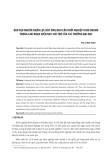
VNU Journal of Science: Economics and Business, Vol. 35, No. 5E (2019) 51-59
51
Original Article
Factors Affecting Employee Cohesion
in Post-Merger Enterprises
Van Thi Bich*, Tran Thi My Huong
Faculty of Administration - International Economics, Lac Hong University,
15/3B Huynh Van Nghe, Buu Long, Bien Hoa, Dong Nai, Vietnam
Received 05 November 2019
Revised 20 December 2019; Accepted 26 December 2019
Abstract: Human resources are invaluable assets of any organization. Employee engagement will
bring many benefits to the organization [1]. Even in difficult times, employee cohesion is an
important competitive different factor of organizations [2]. Findings from a survey sample of
289 employees in post-merger enterprises in retail and pharmaceutical industries showed
influences impact on employee commitment, including (i) Job satisfaction, (ii) Leadership styles,
(iii) Cultural conflict, and (iv) Job stress and pressure. The results of this study provide a
foundation of theory and practice for post-merger or acquisition businesses can efficiently exploit
the human resource for the development in the next period.
Keywords: Culture conflict, organizational commitment, job satisfaction, leadership style, post-
merger, job stress, pressure.
1. Introduction *
Organizational behavior is playing an
important role in supporting, promoting
working results of human resources in the
organization, in which the commitment
behavior of employees in the organization
generally and enterprises after the merger is
very important especially in the context of
vibrant economic development in Vietnam,
_______
* Corresponding author.
E-mail address: bichvt@lhu.edu.vn
https://doi.org/10.25073/2588-1108/vnueab.4296
where competition is taking place so fiercely
that the result may be the acquisition of large
businesses for smaller businesses that often take
place. Besides, the merger is also a very
important strategy for businesses to desire to
expand the market size or market share, access
to desired technology, products, distribution
channels and market position [3].
Organizational change, such as merger and
acquisition (M&A) activity, continue to occur
at a high rate in organizations [4]. However, in
organizational change literature, M&A failures
range from a pessimistic 80% to a more

V.T. Bich, T.T.M. Huong / VNU Journal of Science: Economics and Business, Vol. 35, No. 5E (2019) 51-59
52
optimistic, but still disappointing, 50% [5].
There is undoubtedly a range of contributing
explanations of these high M&As failure rates,
however, recently there has been growing
acceptance among management researchers that
the neglect and mismanagement of the human
aspects during and following the actual merger
or acquisition are significant determinants of
merger success or failure [6]. M&As have come
to be associated with outcomes such as lower
morale and job dissatisfaction, acts of sabotage,
increased labor turnover, and absenteeism rates
rather than increased profitability [7]. There is a
consensus that such change activities result in
reduced organizational commitment [8].
Therefore, the lowered commitment of
employees after periods of mergers and change
is identified as one of the reasons as to why the
intended long-term effects of organizational
change do not succeed [9]. All of these factors
may negatively impact the competitiveness of
the new organization.
Organizational commitment and influencing
factors have received great attention from
scholars with a lot of studies and explanatory
factors tested to predict the commitment
behavior of employees with organizations [10].
However, in the case of post-merger enterprises
in Vietnam, organizational turmoil, cultural
conflicts, leadership styles are strong and
unavoidable that will make organization stable,
personnel, the purification or retention of
personnel has become much more challenging
than an organization that does not have to pay
through such systemic change. Therefore, the
factors affecting the commitment behavior of
workers after the merger with the enterprises,
which will be different from the factors that
govern this behavior in general and need to
have empirical researches are done to identify,
accreditation. This study aims to identify and
analyze the factors affecting the commitment
behavior of employees in post-merger
enterprises in Vietnam context.
2. Review of literature
According to Enterprise Law of Vietnam
(2014), a merger of the enterprise was one or
several companies that can be merged into
another company by transferring all legal
assets, rights, obligations, and benefits to the
merged company, and at the same time stop the
existence of the enterprise merged.
Commitment is widely defined as the extent
of an individual’s loyalty and attachment to an
organization, linked to the degree of effort an
individual will exert to support the
organization’s goals. Meyer and Allen (1991)
widely used three-component commitment
model is based on earlier work by Becker
(1960) and Mowday, Steers, and Porter (1979).
Commitment is the degree of attachment to an
organization [11]. It has three major
components: (i) a strong belief in the
organization and acceptance of the
organization’s goals, (ii) a willingness to exert
considerable effort on behalf of the
organization, and (iii) a desire to maintain
organizational membership [12].
Organizational commitment, a
psychological contract that influences whether
or not to remain affiliated with an organization,
has three basic psychological states: (i)
effective commitment: an employee wants to
stay in the organization because of emotional
attachments, (ii) continuance commitment: an
employee remains with an organization because
he/she has little chance of finding a better job,
and (iii) normative commitment: an employee
feels personally or ethically responsible to
remain with an organization [13]. Studies show
that each of these forms of commitment is
associated with labor turnover. They also
suggest that a strong relationship exists between
affective commitment and a range of desirable
employee outcomes, including attendance, job
performance, good health, low stress, and
minimize conflicts between work and other
activities. As affective commitment is driven by
work experience, rather than through the
recruitment and selection of employees,

V.T. Bich, T.T.M. Huong / VNU Journal of Science: Economics and Business, Vol. 35, No. 5E (2019) 51-59
53
perceived organizational support by employees
is important in this process [14].
There has been a lot of effort from
empirical studies to identify factors that
explained the organizational commitment’s
behavior of employees in post-merger
enterprises. Some important factors tested in
previous studies include working stress,
leadership styles, cultural conflicts, and
job satisfaction.
2.1. Job stress and pressure
Graham, Ramirez, Field, and Richards
(2000) and Elangovan (2001) identified work
stresses for employees related to work-
overload, benefit conflicts, time, staff shortages,
working equipment, conflicts between peers.
Stress threatens the workers’ morale thereby
affecting the reasonable behavior of workers
[15, 16]. The research results showed that work
stress is the main cause of the consequences of
attitudes and behaviors of workers as job
dissatisfaction, will not commit with the
organization [17]. Therefore, when workers have
a lot of stress at work, it will lead to a lack of
long-term commitment to the organization [18].
H1: Perceived job stress and pressure
negatively influence employees’ organizational
commitment in post-merger enterprises.
2.2. Cultural conflict
Cultural conflicts and its important
influence on the success of the merger of
organizations after the merger including
Organizational consolidation and human
resources described in many terms such as
communication stress to describe the behavior
and experience divided after the merger;
Cultural conflicts referred to the negative
reactions of organizational members to the
merger; Mergered syndrome included emotions
about uncertainty and insecurity of mergers;
Cultural conflicts referred to organizational
issues due to failure in cultural harmony in the
post-merger organization [19]. If these issues
are resolved harmoniously or not harmoniously,
it will lead to satisfied/dissatisfied and
loyal/disloyal behavior of employees with the
organization [20]. Abdul Rashid, Sambasivan,
and Johari (2003), Lok and Crawford (2004),
and Sarala (2009) showed the positive impact
of organizational cultural harmonization on the
organization’s commitment of employees
[21-23].
H2: Perceived culture conflict positively
influence employees’ organizational
commitment in post-merger enterprises.
2.3. Leadership styles
Leadership style has an important impact on
the satisfaction, commitment for both the
merger and the merged party's employees, in
which the adaptive factor of leadership style
changes that strongly affected the satisfaction as
well as the employees’ commitment of the
merged party [24]. Being able to integrate
quickly with enterprises after the merger will
help employees with great motivation to
associate with enterprises and the role of
leadership style characterized by relationships,
context, and inspiration, support, and
management will help workers in the process of
rapid integration with the post-merger
organization, thereby helping them connect
with the organization [25]. Purvanova, Bono,
and Dzieweczynski (2006), Marie (2006),
Zhang et al (2015), explained that transitional
leadership style plays a very important role in
creating employee commitment to work. Lok
and Crawford (2004), and Lo, Ramayah, and
Min (2009) explained that the positive behavior
of leaders to motivate employees and enhance
their commitment.
H3: Perceived leadership style positively
influence employees’ organizational
commitment in post-merger enterprises.
2.4. Job satisfaction
Theories of Maslow (1943), and Herzberg
& Mausner (1959), both emphasized the
importance of meeting the different workers'
needs such as jobs, payments, and promotions
that affect their behavior in the organization,
satisfaction, and commitment [26, 27]. Job
satisfaction is the attitude, resulting from

V.T. Bich, T.T.M. Huong / VNU Journal of Science: Economics and Business, Vol. 35, No. 5E (2019) 51-59
54
reviewing and summarizing the specific likes
and dislikes combined with the employees’
evaluation on the work in the organization The
more satisfied the worker is with the job, the
higher the commitment with the organization
[28]. Kyei-Poku and Miller provided evidence
for the relationship between satisfaction with a
merger and the affective and normative
components of organizational commitment
among employees [29].
H4: Perceived job satisfaction positively
influence employees’ organizational
commitment in post-merger enterprises.
3. Methodology
There are 23 items to measure the variables
of the research model (see Table 2). All items
are measured by 5-point Likert scales, which
were 5 - strongly agree, 4 - agree, 3 - not sure,
2 - disagree and 1 - strongly disagree.
According to Hair, Black, Babin, and Anderson
(2010), the sample size used in the exploratory
factor analysis was determined by the minimum
(min = 50) and the number of variables
included in the model. The proportion of
samples compared to an analytical variable was
5/1 or 10/1. Green suggesting that in the
regression model the minimum sample size was
determined by the empirical formula 50 +
8*independent variables in the model [30]. Due
to resource constraints, this study uses a sample
of 289 observations that ensure reliability for
statistical tests in the research model. Table 1
presents descriptive statistics of demographic
characteristics. Questionnaires were
administered to employees of the post-merger
enterprises in the retail and pharmaceutical
industry in Dong Nai province and Ho Chi
Minh City of Vietnam, based on the
non-probability sampling method (with
convenient technique). The surveyed subjects in
this study are employees working at post-
merger enterprises, excluding newly recruited
employees after the merger. The survey was
conducted by the self-administered method, and
employees were encouraged to complete the
survey during work time.
Table 1. Demographic differences
among respondents
Demographic
characteristics
Frequency
Percentage
Gender
Male
Female
144
145
49.8
50.2
Working experience
Less than 5 years
Otherwise
135
154
46.7
53.3
Position post-merger
Higher
Otherwise
146
143
50.5
49.5
Income post-merger
Higher
Otherwise
137
152
47.3
52.7
Types of enterprises
Retail
Pharmacy
147
142
51.0
49.0
4. Results and discussion
4.1. Reliability and validity
The reliability and validity of indicators in
the model are tested by the system of criteria.
As can be seen from Table 2, the lowest
Cronbach’s alpha value was 0.832, exceeding
the cut value of 0.70 recommended [31, 32].
Convergent validity was estimated by factor
loading. The value of Kaiser-Mayer-Olkin
(KMO) was 0.837 (between 0.5 and 1.0) which
means that the data is significant for conducting
a factor analysis. All factor loadings of
variables are higher than the 0.50 (see Table 2).
According to Hair, Black, Babin, and Anderson
(2010), loadings ± 0.50 or greater are
considered practically significant [33].
4.2. Hypothesis testing
The correlation coefficients between the
independent variables are generally low and the
variance inflation factors do not exceed
four suggesting that multicollinearity is unlikely
to prove a significant problem [34, 35]. All
of the hypothesized correlations are
significantly different from zero and have the
anticipated sign.

V.T. Bich, T.T.M. Huong / VNU Journal of Science: Economics and Business, Vol. 35, No. 5E (2019) 51-59
55
Table 2. Results of factor analysis and reliability tests
Items
Scales
Factor
loadings
Job stress and pressure - SP (Cronbach’s Alpha = 0.933)
SP1
I often have to worry and stress at work
0.914
SP2
I often have to worry and stress at work
0.906
SP3
I often get frustrated with things around the work
0.903
SP4
More and more difficult that I have to go through at work
0.898
Cultural conflict - CC (Cronbach’s Alpha = 0.841)
CC1
I always feel comfortable as communicating with other members after merging
0.829
CC2
I completely caught up with the new workflow after merging
0.829
CC3
The working environment is not different with me after merging
0.807
CC4
I have the same value as the organization after merging
0.743
Leadership styles - LS (Cronbach’s Alpha = 0.832)
LS1
I have a good relationship with senior management after merging
0.834
LS2
Senior management helps me build relationships with other members after merging
0.772
LS3
Superior management gives me the inspiration to work after merging
0.765
LS4
Superior management supports me a lot about the work after merging
0.764
LS5
Superior management helps me to integrate quickly after merging
0.621
Job satisfaction - JS (Cronbach’s Alpha = 0.917)
JS1
Basic salary is paid following the time and workload
0.887
JS2
I am satisfied with the opportunity to raise wages
0.849
JS3
My work is respected by society
0.848
JS4
I believe that promotion opportunities are fair
0.806
JS5
I have a chance to quickly advance in my work
0.796
Organizational commitment - OC (Cronbach’s Alpha = 0.901)
OC1
I always try my best to help the company after a successful merger
0.884
OC2
I'm always proud to talk about where I work after merging
0.878
OC3
I have great loyalty to the company after merging
0.844
OC4
Post-merger enterprises always create great excitement for me to develop my full
capacity
0.836
OC5
I feel that choosing to stay in the business after merging is right
0.798
Table 3. Results of Correlation Analysis
OC
JS
LS
SP
CC
OC
Pearson correlation
1
.753
.631
-.300
.510
Sig. (2-tailed)
.000
.000
.000
.000
N
289
289
289
289
289
JS
Pearson correlation
.753
1
.450
-.174
.279
Sig. (2-tailed)
.000
.000
.003
.000
N
289
289
289
289
289
LS
Pearson correlation
.631
.450
1
-.177
.361
Sig. (2-tailed)
.000
.000
.003
.000
N
289
289
289
289
289
SP
Pearson correlation
-.300
-.174
-.177
1
-.151
Sig. (2-tailed)
.000
.003
.003
.010
N
289
289
289
289
289
CC
Pearson correlation
.510
.279
.361
-.151
1
Sig. (2-tailed)
.000
.000
.000
.010
N
289
289
289
289
289


























